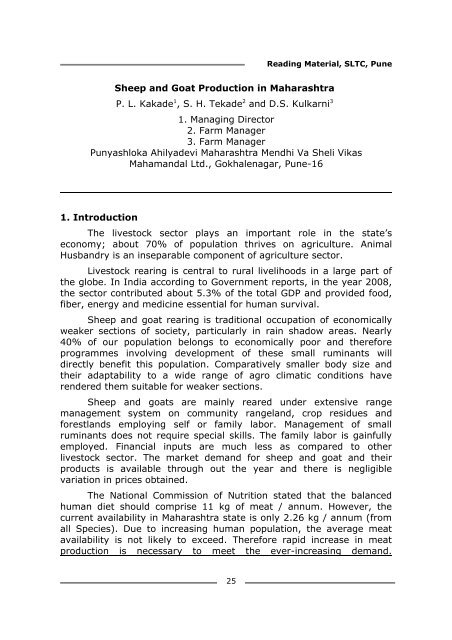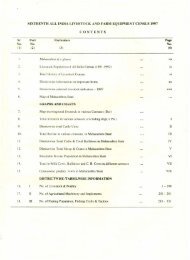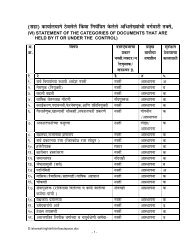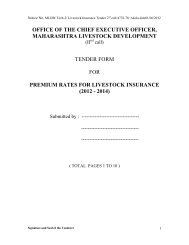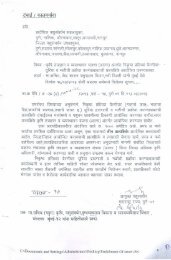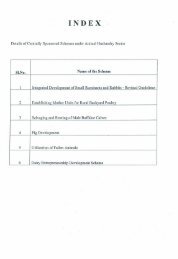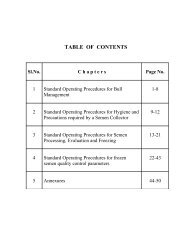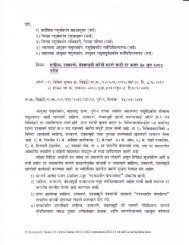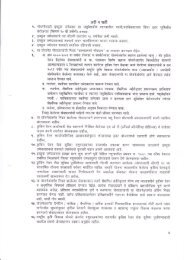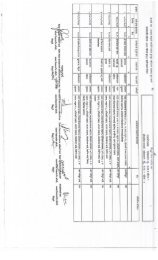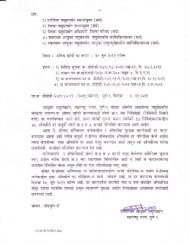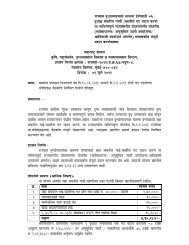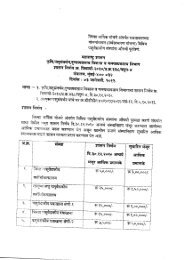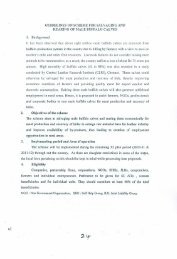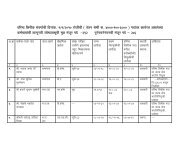Sheep and Goat Production in Maharashtra - Animal Husbandry ...
Sheep and Goat Production in Maharashtra - Animal Husbandry ...
Sheep and Goat Production in Maharashtra - Animal Husbandry ...
You also want an ePaper? Increase the reach of your titles
YUMPU automatically turns print PDFs into web optimized ePapers that Google loves.
25<br />
Read<strong>in</strong>g Material, SLTC, Pune<br />
<strong>Sheep</strong> <strong>and</strong> <strong>Goat</strong> <strong>Production</strong> <strong>in</strong> <strong>Maharashtra</strong><br />
P. L. Kakade 1 , S. H. Tekade 2 <strong>and</strong> D.S. Kulkarni 3<br />
1. Manag<strong>in</strong>g Director<br />
2. Farm Manager<br />
3. Farm Manager<br />
Punyashloka Ahilyadevi <strong>Maharashtra</strong> Mendhi Va Sheli Vikas<br />
Maham<strong>and</strong>al Ltd., Gokhalenagar, Pune-16<br />
1. Introduction<br />
The livestock sector plays an important role <strong>in</strong> the state’s<br />
economy; about 70% of population thrives on agriculture. <strong>Animal</strong><br />
Husb<strong>and</strong>ry is an <strong>in</strong>separable component of agriculture sector.<br />
Livestock rear<strong>in</strong>g is central to rural livelihoods <strong>in</strong> a large part of<br />
the globe. In India accord<strong>in</strong>g to Government reports, <strong>in</strong> the year 2008,<br />
the sector contributed about 5.3% of the total GDP <strong>and</strong> provided food,<br />
fiber, energy <strong>and</strong> medic<strong>in</strong>e essential for human survival.<br />
<strong>Sheep</strong> <strong>and</strong> goat rear<strong>in</strong>g is traditional occupation of economically<br />
weaker sections of society, particularly <strong>in</strong> ra<strong>in</strong> shadow areas. Nearly<br />
40% of our population belongs to economically poor <strong>and</strong> therefore<br />
programmes <strong>in</strong>volv<strong>in</strong>g development of these small rum<strong>in</strong>ants will<br />
directly benefit this population. Comparatively smaller body size <strong>and</strong><br />
their adaptability to a wide range of agro climatic conditions have<br />
rendered them suitable for weaker sections.<br />
<strong>Sheep</strong> <strong>and</strong> goats are ma<strong>in</strong>ly reared under extensive range<br />
management system on community rangel<strong>and</strong>, crop residues <strong>and</strong><br />
forestl<strong>and</strong>s employ<strong>in</strong>g self or family labor. Management of small<br />
rum<strong>in</strong>ants does not require special skills. The family labor is ga<strong>in</strong>fully<br />
employed. F<strong>in</strong>ancial <strong>in</strong>puts are much less as compared to other<br />
livestock sector. The market dem<strong>and</strong> for sheep <strong>and</strong> goat <strong>and</strong> their<br />
products is available through out the year <strong>and</strong> there is negligible<br />
variation <strong>in</strong> prices obta<strong>in</strong>ed.<br />
The National Commission of Nutrition stated that the balanced<br />
human diet should comprise 11 kg of meat / annum. However, the<br />
current availability <strong>in</strong> <strong>Maharashtra</strong> state is only 2.26 kg / annum (from<br />
all Species). Due to <strong>in</strong>creas<strong>in</strong>g human population, the average meat<br />
availability is not likely to exceed. Therefore rapid <strong>in</strong>crease <strong>in</strong> meat<br />
production is necessary to meet the ever-<strong>in</strong>creas<strong>in</strong>g dem<strong>and</strong>.
26<br />
Read<strong>in</strong>g Material, SLTC, Pune<br />
Nutritional Advisory Committee of Indian Institute of Medical Research<br />
recommended every Indian should get 280 gms. of milk per day per<br />
capita , but as per statistical report of GOI for the period –2006,<br />
availability is 245 gms. per capita per day. <strong>Maharashtra</strong> ranks third <strong>in</strong><br />
Meat production <strong>and</strong> eighth <strong>in</strong> wool production amongst all states of<br />
India (Source: Basic <strong>Animal</strong> Husb<strong>and</strong>ry Statistics, 2006).<br />
1.1. <strong>Sheep</strong> <strong>and</strong> <strong>Goat</strong> Population:<br />
As per livestock census of 2008, the population of sheep <strong>and</strong> goat<br />
<strong>in</strong> the state is 32.57 lakhs <strong>and</strong> 109.81 lakh respectively.<br />
Table-1 :Division wise <strong>Sheep</strong> <strong>and</strong> <strong>Goat</strong>s (Provisional 2007)<br />
Sr.<br />
No.<br />
Name of the<br />
Division<br />
1 Mumbai<br />
(Konkan)<br />
No. of<br />
<strong>Sheep</strong><br />
Wool<br />
Productio<br />
n dur<strong>in</strong>g<br />
the year<br />
2008-09<br />
(MTs)<br />
No. of<br />
<strong>Goat</strong>s<br />
<strong>Goat</strong> Milk<br />
<strong>Production</strong><br />
dur<strong>in</strong>g the<br />
year 08-09.<br />
(000 MTs.)<br />
3126 12.959 352112 10.186<br />
2 Nasik 1377376 566.225 3173555 77.692<br />
3 Pune 1626976 777.112 2369037 63.887<br />
4 Aurangabad 235509 158.392 1185165 46.795<br />
5 Latur 165910 81.508 919395 19.258<br />
6 Amravati 198544 74.298 1440810 39.163<br />
7 Nagpur 69790 36.773 1541107 20.269<br />
Total 3257562 1707.287 1098118<br />
1<br />
277.250<br />
As per livestock census of year 2003, on National level <strong>Maharashtra</strong><br />
ranks 6 th <strong>in</strong> <strong>Sheep</strong> population <strong>and</strong> 4 th <strong>in</strong> <strong>Goat</strong> population.<br />
1.2. <strong>Sheep</strong> <strong>and</strong> goat rear<strong>in</strong>g<br />
Approximately 92,500 families are depend<strong>in</strong>g upon sheep rear<strong>in</strong>g<br />
bus<strong>in</strong>ess. <strong>Sheep</strong> rear<strong>in</strong>g is done <strong>in</strong> dry climatic districts such as Pune,<br />
Satara, Solapur, Sangli, Kolhapur, Ahmadnagar, Nasik, Dhule, Jalgaon,
27<br />
Read<strong>in</strong>g Material, SLTC, Pune<br />
Aurangabad, Jalna, Beed, Latur, N<strong>and</strong>ed, Osmanabad, Buldhana,<br />
Ch<strong>and</strong>rapur, etc. In goat rear<strong>in</strong>g, approximately 48 lakhs families are<br />
engaged. Both the bus<strong>in</strong>ess is carried out by weaker sections of the<br />
society.<br />
1.3. Meat <strong>Production</strong><br />
<strong>Goat</strong>s \ <strong>Sheep</strong> constitute a very important species of livestock <strong>in</strong><br />
India, ma<strong>in</strong>ly on account of their short generation <strong>in</strong>tervals, higher<br />
rates of prolificacy, <strong>and</strong> the ease with which the goats as also their<br />
products can be marketed. They are considered to be very important<br />
for their contribution to the development of rural zones <strong>and</strong> people. The<br />
local <strong>in</strong>itiatives to promote quality labels <strong>and</strong> <strong>in</strong>novative products for<br />
cheeses, meat <strong>and</strong> fibres could help goats <strong>in</strong> keep<strong>in</strong>g a role for<br />
susta<strong>in</strong>able development <strong>in</strong> an eco-friendly environment all over the<br />
world. However, the future of the goat <strong>and</strong> sheep <strong>in</strong>dustry as a<br />
significant economic activity will also be very dependent on the<br />
st<strong>and</strong>ards of liv<strong>in</strong>g <strong>in</strong> the countries where there is a market for the goat<br />
products.<br />
As per Statistical Report of Dept. of <strong>Animal</strong> Husb<strong>and</strong>ry,<br />
<strong>Maharashtra</strong> State for the year 2008 – 2009, <strong>Sheep</strong> <strong>and</strong> goat meat<br />
production is about 34.52 % of total meat production <strong>in</strong> the state of<br />
which 11.34 % is from sheep <strong>and</strong> 23.18 % is from goats. Estimated<br />
average meat production per sheep <strong>and</strong> goat is 11 kg.<br />
Table-2 :Estimated meat production from all species of animal <strong>in</strong><br />
<strong>Maharashtra</strong> (2008-09)<br />
Sr.<br />
No.<br />
Species No. of<br />
<strong>Animal</strong><br />
Slaughtered<br />
(000” Nos).<br />
Average<br />
meat<br />
production /<br />
<strong>Animal</strong><br />
(kgs)<br />
Total meat<br />
production<br />
(000 MT)<br />
Percentage<br />
contribution<br />
1. Cattle 511.421 126.223 64.553 25.21<br />
2. Buffalo 703.115 138.738 97.549 38.10<br />
3. <strong>Sheep</strong> 2466.183 11.772 29.033 11.34<br />
4. <strong>Goat</strong> 5112.838 11.611 59.366 23.18<br />
5. Pig 218.404 25.274 5.520 2.15<br />
Total Total 256.021 100.00<br />
(Source: Integrated Survey Scheme Report on Milk, Egg, Wool <strong>and</strong><br />
Meat <strong>Production</strong> <strong>in</strong> <strong>Maharashtra</strong> State for the year 2008-09)
Read<strong>in</strong>g Material, SLTC, Pune<br />
Table-3 : Number of Registered Slaughterhouses <strong>in</strong> the State<br />
Sr. No. District No. of Registered Slaughterhouses<br />
1 Brihan Mumbai 1<br />
2 Thane 3<br />
3 Raigad 1<br />
4 S<strong>in</strong>dhudurg 2<br />
5 Nashik 10<br />
6 Dhule 4<br />
7 Nadurbar 5<br />
8 Jalgaon 19<br />
9 Ahmednagar 7<br />
10 Pune 8<br />
11 Satara 12<br />
12 Sangali 2<br />
13 Kolhapur 13<br />
14 Solapur 4<br />
15 Latur 6<br />
16 Osmanabad 4<br />
17 Beed 11<br />
18 Aurangabad 11<br />
19 Jalna 5<br />
20 Buldhana 47<br />
21 Parbhani 6<br />
22 N<strong>and</strong>ed 17<br />
23 H<strong>in</strong>goli 11<br />
24 Akola 28<br />
25 Washim 14<br />
26 Amravati 26<br />
27 Yavatmal 30<br />
28 Wardha 6<br />
29 Nagpur 14<br />
30 Bh<strong>and</strong>ara 1<br />
31 Gadchiroli 3
32 Ch<strong>and</strong>rapur 7<br />
Total 338<br />
29<br />
Read<strong>in</strong>g Material, SLTC, Pune<br />
(Source: Integrated Survey Scheme Report on Milk, Egg, Wool <strong>and</strong><br />
Meat <strong>Production</strong> <strong>in</strong> <strong>Maharashtra</strong> State for the year 2008-09)<br />
1.4. Export of Meat<br />
The world production of <strong>Sheep</strong> meat was 8.89 million tones <strong>and</strong><br />
<strong>Goat</strong> meat was 5.14 million tones <strong>in</strong> 2007.(FAO Stat Website) India<br />
ranked sixth <strong>in</strong> sheep <strong>and</strong> second <strong>in</strong> goat meat production, Ch<strong>in</strong>a<br />
stood first <strong>in</strong> <strong>Sheep</strong> as well <strong>Goat</strong> meat production. India’s export of<br />
sheep/goat meat has been <strong>in</strong>creased from Rs. 65.87 Crores <strong>in</strong> 2006-07<br />
to Rs.134.10 Crores <strong>in</strong> 2007-08 (APEDA).<br />
Major Export Dest<strong>in</strong>ations of India (2007-08):<br />
Saudi Arabia, UAE, Qatar, Germany, Oman (APEDA)<br />
Table-4 : Yearwise <strong>Sheep</strong> <strong>and</strong> <strong>Goat</strong> Meat Export (Source:<br />
APEDA)<br />
Year 2005-06 2006-07 2007-08<br />
Quantity ( <strong>in</strong> MT) 7272.97 5777.52 8908.72<br />
Value (<strong>in</strong> Lakhs) 8104.24 6587.23 13409.96<br />
1.5. Wool <strong>Production</strong><br />
The sheep of the state grow a coarse type of wool. The sheep are<br />
shorn twice dur<strong>in</strong>g a year. The first shear<strong>in</strong>g is done dur<strong>in</strong>g June <strong>and</strong><br />
July. The second shear<strong>in</strong>g is done after six months, of the first<br />
shear<strong>in</strong>g.<br />
The overall average estimated wool yield per sheep shorn is 585<br />
gms. The coloration <strong>in</strong> Deccani wool is Black, White, Mixed is 57:27:15<br />
respectively. As per statistical report of Department of <strong>Animal</strong><br />
Husb<strong>and</strong>ry for the year 2008 –09 the estimated wool production of the<br />
State dur<strong>in</strong>g the year is 1707 M. T.
1.6 <strong>Goat</strong> Milk <strong>Production</strong><br />
30<br />
Read<strong>in</strong>g Material, SLTC, Pune<br />
The estimated <strong>Goat</strong> milk production for the state dur<strong>in</strong>g 2008-<br />
09 was 277.248 thous<strong>and</strong> M.T. The average milk yield per goat <strong>in</strong>milk<br />
per day was about 219 gms. Contribution of <strong>Goat</strong> Milk <strong>in</strong> total<br />
milk production is approximately 4 per cent<br />
Table – 6: Species wise Milk <strong>Production</strong> <strong>in</strong> the State<br />
Sr.<br />
No.<br />
Species Estimated<br />
no. of<br />
<strong>Animal</strong>s <strong>in</strong><br />
milk (lakh)<br />
Average<br />
daily milk<br />
yield/<br />
animal-<strong>in</strong>milk<br />
Total Milk<br />
<strong>Production</strong><br />
(000’ M.<br />
T.)<br />
1 C. B. Cows 1180 6.541 2817.166<br />
2 Cows other than C.<br />
B. Cows<br />
1943 1.503 1066.248<br />
3 Buffaloes 2395 3.768 3294.495<br />
4 <strong>Goat</strong> 3475 0.219 277.248<br />
Total 7455.157<br />
(Source: Integrated Survey Scheme Report on Milk, Egg, Wool <strong>and</strong><br />
Meat <strong>Production</strong> <strong>in</strong> <strong>Maharashtra</strong> State for the year 2008-09)<br />
Table 7: Estimated Gross Income from <strong>Goat</strong> –<br />
<strong>Sheep</strong> sector (2006-07)<br />
Sr.<br />
No<br />
.<br />
A <strong>Goat</strong><br />
Particulars Productio<br />
n<br />
(MTS)<br />
Rate Per<br />
Ton. Rs.<br />
Value<br />
(Rs. In<br />
Lakhs)<br />
1 Meat 556700.00 13657.34 76030.40<br />
2 Head s 38784.00 7379.91 2862.24<br />
3 Legs 22955.00 8110.05 1861.64<br />
4 Sk<strong>in</strong>s 269335.00 5907.49 15910.93<br />
5 Edible offal 34573.00 7351.66 2541.67<br />
6 Fats 14005.00 13743.29 1924.81
31<br />
Read<strong>in</strong>g Material, SLTC, Pune<br />
7 Horns 3834.00 734.20 28.15<br />
8 Blood 34003.00 3124.31 1062.37<br />
9 Guts/Pouch 35618.00 4938.54 1758.19<br />
10 Esophagus. 3784.00 5139.18 194.45<br />
11 <strong>Goat</strong> Hairs 352.00 50362.41 177.48<br />
12 <strong>Goat</strong> Milk (MT) 280960.00 13908.28 39076.71<br />
13 Hoofs 2977.00 734.20 21.85<br />
Total Gross <strong>in</strong>come from <strong>Goat</strong> Sector 1,43,451.69<br />
B <strong>Sheep</strong><br />
1 Meat 266710.00 13061.14 34835.36<br />
2 Heads 18896.00 6833.29 1291.24<br />
3 Legs 13044.00 7495.05 977.30<br />
4 Sk<strong>in</strong>s 128150.00 4356.78 5583.21<br />
5 Edible offal 16496.00 6987.54 1152.69<br />
6 Fats 5103.00 13273.29 677.30<br />
7 Horns 1452.00 1042.31 15.13<br />
8 Blood 13649.00 3390.51 462.76<br />
9 Guts/Pouch 21853.00 5331.48 1165.07<br />
10 Esophagus. 895.00 4804.49 43.02<br />
11 Hoof 1137.00 1042.31 11.86<br />
12 Wool 1667.00 59671.98 994.60<br />
Total Gross <strong>in</strong>come from <strong>Sheep</strong> Sector 47209.80<br />
Total Gross Income from Livestock <strong>and</strong><br />
Poultry sector<br />
13,27,437.00<br />
Contribution of <strong>Goat</strong> sector 10.80%<br />
Contribution of <strong>Sheep</strong> sector 3.55 %<br />
Total Contribution of <strong>Sheep</strong> <strong>and</strong> <strong>Goat</strong> Sector 14.35
2. <strong>Goat</strong> Breeds of the State<br />
32<br />
Read<strong>in</strong>g Material, SLTC, Pune<br />
Osmanabadi, Sangamneri, Surti Breed as well as non-descript goats are<br />
reared <strong>in</strong> the State.<br />
a) Osmanabadi Breed<br />
Osmanabadi is a ma<strong>in</strong> goat breed of the State. This breed is<br />
orig<strong>in</strong>ated <strong>and</strong> habitat of Osmanabad District <strong>and</strong> its adjacent<br />
district of <strong>Maharashtra</strong>-Andhra-Pradesh States. Osmanabadi goats<br />
are ma<strong>in</strong>ly black <strong>in</strong> color (73%), rema<strong>in</strong><strong>in</strong>g are patches with blackwhite,<br />
tan or patches with tan- white are also observed. Tw<strong>in</strong><strong>in</strong>g<br />
percentage is approximately 35% to 40%, triplets are 3-5% <strong>and</strong><br />
quadruplet’s is 1-3%, rema<strong>in</strong><strong>in</strong>g are s<strong>in</strong>gles. Osmanabadi is a<br />
medium size <strong>and</strong> dual type of breed. These goats are hardy <strong>and</strong><br />
three kidd<strong>in</strong>g <strong>in</strong> two years are observed. Average birth weight is<br />
approximately 2.5 to 3kg. And they are sold at the age of 8 to 9<br />
months, i.e.18 to 20 kg. of body weight. Average meat yield is 40<br />
to 45% <strong>and</strong> milk production is 180 lts. <strong>in</strong> 210 days of lactation<br />
period.<br />
b) Surti<br />
Surti goats are found <strong>in</strong> Nasik, Dhule, Jalgaon districts of the<br />
Kh<strong>and</strong>esh area, which are adjacent to the Surat district of Gujrat<br />
State which is habitat of Surti breed. Surti goats are famous for<br />
milk; it is a medium size breed, white <strong>in</strong> color, medium sized ear,<br />
small horns, <strong>and</strong> very well developed udder. It is very useful for<br />
stall-fed rear<strong>in</strong>g system. The average milk yield is 150 liters per<br />
lactation of 165 days.<br />
c) Sangamneri<br />
Sangamneri goats are habitat of “ Sangamner”, <strong>and</strong> its neighbour<br />
talukas of Ahmadnagar district <strong>and</strong> are also found <strong>in</strong> Junnar taluka<br />
of Pune district. Sangamneri goats are famous for meat purpose.<br />
It is also a medium size breed, ma<strong>in</strong>ly white <strong>in</strong> color, but black or<br />
brown spots are also found <strong>in</strong> this breed. Ears are medium <strong>and</strong><br />
droop<strong>in</strong>g, udder is small. In this breed tw<strong>in</strong>n<strong>in</strong>g is approximately<br />
54%, s<strong>in</strong>gle 42%, triplets 3% <strong>and</strong> quadriplates are 1%. The<br />
average milk yield is 70 to 80 lts <strong>in</strong> 90 days of lactation.<br />
d) Kanyal<br />
Kanyal goats are found <strong>in</strong> Kudal, Sawantwadi, Dodamarg, Malvan<br />
<strong>and</strong> Vengurle talukas of S<strong>in</strong>dhudurg district of Konkon. These<br />
goats are black, white mark<strong>in</strong>g on collar, <strong>and</strong> lower jaw, ventral<br />
surface is white, <strong>and</strong> muzzle is white, half moon type. Average
33<br />
Read<strong>in</strong>g Material, SLTC, Pune<br />
birth weight is 1.99 kg; at 3 rd month is 8.69 kg, 6 month13.79kg.<br />
These goats are regular breeder <strong>and</strong> breeds round the year.<br />
Tw<strong>in</strong>n<strong>in</strong>g percentage is about 66 %. Research on this breed is<br />
undertaken by Dr. Balasaheb Sawant Konkon Krishi Vidyapeeth,<br />
Dapoli., Dist. Ratnagiri.<br />
3. <strong>Sheep</strong> Breeds of the State<br />
A) Deccani<br />
The breed of sheep reared <strong>in</strong> the <strong>Maharashtra</strong> is called as Deccani<br />
sheep. Predom<strong>in</strong>antly sheep population black (57%), white<br />
(28%), <strong>and</strong> mixed color (15%). Deccani breed has some<br />
prom<strong>in</strong>ent stra<strong>in</strong>s such as Lon<strong>and</strong>, Sangamneri, Solapuri(Sangola)<br />
<strong>and</strong> Kolhapuri.<br />
a. Lon<strong>and</strong><br />
These types of sheep are found <strong>in</strong> Jejuri, Indapur area of Pune<br />
district <strong>and</strong> Lon<strong>and</strong> area of Satara district. These sheep are<br />
predom<strong>in</strong>antly white <strong>in</strong> color, wool is rough <strong>in</strong> nature.<br />
b. Sangola<br />
These types of sheep are found <strong>in</strong> Sangola taluka of Solapur<br />
district. Majority of these sheep are black <strong>in</strong> color, wool is f<strong>in</strong>e <strong>and</strong><br />
long, hence fetches good price.<br />
c. Sangamneri<br />
These types of sheep are found <strong>in</strong> Sangamner taluka of<br />
Ahmadnagar district <strong>and</strong> Yeola & N<strong>and</strong>gaon talukas of Nashik<br />
district. These sheep are tall <strong>and</strong> tan-black face, white body is a<br />
ma<strong>in</strong> feature of this breed. These sheep are strong <strong>and</strong> hardy.<br />
d. Kolhapuri<br />
These sheep are found <strong>in</strong> Kolhapur district <strong>and</strong> its adjacent districts<br />
of Karnataka State. These sheep are ak<strong>in</strong> to Bellary sheep of<br />
Karnataka.
A) Madgyal<br />
34<br />
Read<strong>in</strong>g Material, SLTC, Pune<br />
This sheep is habitat of village Madagyal Tal- Jat Dist- Sangali. Pure<br />
forms of sheep are found <strong>in</strong> Madgyal Abachiwadi, P<strong>and</strong>ozari,<br />
Sanmadi, Sonyal, Kunikunar, Asangi, Sang, Daribadchi, Mirwan,<br />
Ankali <strong>and</strong> Shegaon.<br />
This sheep have prom<strong>in</strong>ently white with brown patches <strong>and</strong><br />
Roman nose is typical character of this breed. This breed has got<br />
average weight ga<strong>in</strong> of 200- 225 gms per day, <strong>and</strong> hence it is<br />
known as meat breed. Wool is rough <strong>and</strong> annual yield is 250-260<br />
gms.<br />
4. NGOS work<strong>in</strong>g on <strong>Sheep</strong> <strong>and</strong> <strong>Goat</strong>s<br />
a. Nimbkar Agriculture Research Institute (NARI, Phaltan)<br />
The <strong>in</strong>stitute is ma<strong>in</strong>ta<strong>in</strong><strong>in</strong>g <strong>in</strong>digenous <strong>and</strong> pure exotic Boer,<br />
Damascus <strong>and</strong> their crosses <strong>and</strong> supplies rams <strong>and</strong> bucks for<br />
breed<strong>in</strong>g purpose to the farmers. It is also impart<strong>in</strong>g tra<strong>in</strong><strong>in</strong>g <strong>in</strong><br />
<strong>Goat</strong> AI programme. It is hav<strong>in</strong>g semen freez<strong>in</strong>g lab <strong>and</strong> tra<strong>in</strong>ed<br />
staff <strong>and</strong> a diagnostic as well as biotechnology labs to carry out<br />
different <strong>in</strong>vestigations. NARI is supply<strong>in</strong>g the rams carry<strong>in</strong>g one or<br />
two copies of the Fec B gene to <strong>in</strong>crease prolificacy of the<br />
Shepherd’s Deccani ewes.<br />
b. BAIF Development Research Foundation, Uralikanchan, Pune<br />
<strong>Goat</strong> breed<strong>in</strong>g <strong>and</strong> improvement activity has been taken up by<br />
BAIF <strong>in</strong> Maharastra, Karnataka <strong>and</strong> West Bengal State. The<br />
activities of BAIF <strong>in</strong>clude regular Vacc<strong>in</strong>ations <strong>and</strong> deworm<strong>in</strong>g at<br />
village level, tra<strong>in</strong><strong>in</strong>g programmes for farmers, women SHGs,<br />
tra<strong>in</strong><strong>in</strong>g <strong>in</strong> AI for <strong>Sheep</strong> <strong>and</strong> <strong>Goat</strong>, production of frozen semen<br />
pallets.<br />
c. ANTHRA, Bavdhan, Pune<br />
The NGO is publish<strong>in</strong>g <strong>and</strong> distribut<strong>in</strong>g educational material to the<br />
<strong>Sheep</strong> <strong>and</strong> <strong>Goat</strong> farmers. They are also supply<strong>in</strong>g herbal medic<strong>in</strong>e<br />
where needed <strong>and</strong> also provid<strong>in</strong>g tra<strong>in</strong><strong>in</strong>g to the farmers.<br />
d. BOSCO Gram<strong>in</strong> Vikas Kendra, Kedgaon, Ahmednagar
35<br />
Read<strong>in</strong>g Material, SLTC, Pune<br />
This was started <strong>in</strong> 1986 with ma<strong>in</strong> objective to implement<br />
Watershed Development Programme <strong>in</strong> Nagar District. They are<br />
promot<strong>in</strong>g SHGs with goat farm<strong>in</strong>g. It also has tra<strong>in</strong><strong>in</strong>g centre.<br />
The farm has started boer goat cross<strong>in</strong>g <strong>in</strong> 2001.<br />
e. Rural Agriculture Institute, Narayangaon (RAIN)<br />
Sanen goat was imported from Engl<strong>and</strong>, Israel <strong>and</strong> Australia for<br />
breed<strong>in</strong>g purpose .This <strong>in</strong>stitute is supply<strong>in</strong>g Sanen bucks<br />
throughout India. This NGO also conducts <strong>Goat</strong> Management<br />
Tra<strong>in</strong><strong>in</strong>g courses.<br />
5. Conservation of Indigenous Breeds<br />
1. Breeder’s Association for each breed of <strong>Sheep</strong> <strong>and</strong> <strong>Goat</strong><br />
In <strong>Maharashtra</strong>, Osmanabadi, Sangamneri, Konkon Kanyal are the ma<strong>in</strong><br />
goat breeds <strong>and</strong> <strong>in</strong> sheep Deccani, Madgyal are the ma<strong>in</strong> breeds.<br />
At present, there is only one breeders association i.e. Samajratna<br />
Shivajirao Shendge <strong>Sheep</strong> <strong>and</strong> <strong>Goat</strong> Breeders <strong>and</strong> Wool Producers<br />
Development Board (Reg. No. MH/487/2007/Pune) work<strong>in</strong>g <strong>in</strong><br />
<strong>Maharashtra</strong> for development of Deccani Breed.<br />
The Association was started on 22/03/2007 <strong>and</strong> there are 1209<br />
members registered with this Association. It works with this<br />
Corporation for implement<strong>in</strong>g “Integrated <strong>Sheep</strong> <strong>and</strong> Wool<br />
Development Scheme” <strong>in</strong> Sangali District. Association is also<br />
implement<strong>in</strong>g the programmes of Central Wool Development Board,<br />
Jodhpur.<br />
7. A. I. Activities <strong>in</strong> <strong>Maharashtra</strong><br />
At present, breed<strong>in</strong>g on farms of the Corporation as well as <strong>in</strong> the field<br />
is carried out through natural breed<strong>in</strong>g only. However, to achieve the<br />
results of upgrad<strong>in</strong>g at a faster rate over a wider area, A.I. is a useful<br />
tool. The technique will also help <strong>in</strong> <strong>in</strong>creas<strong>in</strong>g the availability of<br />
superior quality rams <strong>and</strong> bucks.<br />
In <strong>Maharashtra</strong> NGOs like NARI, Phaltan <strong>and</strong> BAIF, Uruli-Kanchan, Pune<br />
are implement<strong>in</strong>g A.I. techniques <strong>in</strong> sheep <strong>and</strong> goat, on their farms as<br />
well as under field conditions. NARI, Phaltan is promot<strong>in</strong>g cross<br />
breed<strong>in</strong>g <strong>in</strong> goats us<strong>in</strong>g frozen semen of Boer goat. Where as BAIF is
36<br />
Read<strong>in</strong>g Material, SLTC, Pune<br />
promot<strong>in</strong>g Awassi <strong>and</strong> Madras Red breeds of sheep <strong>and</strong> Sanen,<br />
Osmanabadi, Sirohi, Barberi <strong>and</strong> Jamunapari breeds of goat.<br />
8. Breed Registration<br />
As per report of NBAGR, Karnal, the registered breed of <strong>Sheep</strong> <strong>and</strong><br />
<strong>Goat</strong> <strong>in</strong> <strong>Maharashtra</strong> State are –<br />
Sr.<br />
No.<br />
Breed Registration No.<br />
<strong>Goat</strong> Breeds<br />
1. Osmanabadi INDIA_GOAT_1100_ OSMANABADI _06017<br />
2. Sagamneri INDIA_GOAT_1100_ SANGAMNERI _06018<br />
<strong>Sheep</strong> Breed<br />
1. Deccani INDIA_SHEEP_0111_DECCANI_14021<br />
Phenotypic <strong>and</strong> genotypic characterization studies of other sheep <strong>and</strong><br />
goat breeds of <strong>Maharashtra</strong> should be undertaken <strong>and</strong> should be<br />
registered accord<strong>in</strong>gly.<br />
9. BREEDING POLICY FOR SHEEP <strong>and</strong> GOAT<br />
A) Task Force on <strong>Sheep</strong>, <strong>Goat</strong> <strong>and</strong> Rabbit <strong>Production</strong> dur<strong>in</strong>g<br />
1996<br />
M<strong>in</strong>istry of Agriculture, Department of <strong>Animal</strong> Husb<strong>and</strong>ry <strong>and</strong> Dairy<strong>in</strong>g,<br />
Government of India established Task Force on <strong>Sheep</strong>, <strong>Goat</strong> <strong>and</strong> Rabbit<br />
<strong>Production</strong> dur<strong>in</strong>g 1996. The Task Force considered several strategies<br />
for small rum<strong>in</strong>ants <strong>and</strong> rabbit development <strong>in</strong> the country. It was felt<br />
that on station animal breed<strong>in</strong>g did not yield desired results <strong>in</strong> terms of<br />
impacts <strong>and</strong> acceptance by farmers. Efforts so far have been sporadic<br />
<strong>and</strong> isolated from the realities (1.3.6, page no. ii).<br />
After review of all available <strong>in</strong>formation, task force recommended that,<br />
“In goats, limited experimental breed<strong>in</strong>g programme with Alp<strong>in</strong>e <strong>and</strong><br />
Toggenburg be taken <strong>in</strong> field <strong>in</strong> Rajasthan. Results <strong>in</strong>dicate that exotic<br />
germplasms <strong>and</strong> cross breeds donor performs better than <strong>in</strong>digenous
37<br />
Read<strong>in</strong>g Material, SLTC, Pune<br />
animals under similar field conditions. Another farm based experiment<br />
at a smaller scale was attempted to produce Angora fibre by cross<br />
breed<strong>in</strong>g <strong>in</strong>digenous goats with Angora bucks <strong>in</strong> Himachal Pradesh,<br />
Jammu – Kashmir, <strong>Maharashtra</strong> <strong>and</strong> Rajasthan. This experiment was<br />
not successful, as farmers did not adopt the new genotype. With the<br />
threat of diseases such as Capr<strong>in</strong>e Arthritis, it is recommended that no<br />
breed improvement programmes which <strong>in</strong>volves large scale importation<br />
of exotic goats from Europe <strong>and</strong> other countries where disease has<br />
been endemic should be taken up. Wherever exotic germplasm is<br />
available <strong>in</strong> the country, the same should be tested for CAE <strong>and</strong> other<br />
diseases <strong>and</strong> pooled at two or more locations. Further, <strong>in</strong>digenous<br />
breeds of goats have high prolificacy, which is lost when cross breed<strong>in</strong>g<br />
is undertaken. The number of kids weaned per doe be<strong>in</strong>g an important<br />
economic trait <strong>and</strong> as the species is the preferred animal for meat,<br />
<strong>in</strong>discrim<strong>in</strong>ate <strong>in</strong>troduction of exotic blood is not desirable [Para 3.5(iii )<br />
:53].<br />
<strong>Goat</strong> <strong>and</strong> sheep breed<strong>in</strong>g policy recommended by Task Force<br />
Committee for <strong>Maharashtra</strong> is as under:<br />
I) <strong>Goat</strong>:<br />
a. Breed<strong>in</strong>g Policy: The ma<strong>in</strong> thrust is to improve Osmanabadi,<br />
Surti <strong>and</strong> Sangamneri breeds but no breed<strong>in</strong>g policy has been<br />
implemented to improve the local non-descript goats.<br />
b. Recommendations: Selective breed<strong>in</strong>g should cont<strong>in</strong>ue for the<br />
three breeds. Non-descript goats should be upgraded with<br />
Osmanabadi /Sirohi/Kutchi. Open nucleus herds should be<br />
established at exist<strong>in</strong>g goat farms (Para No: 3.5.11:58).<br />
II) <strong>Sheep</strong>:<br />
a. Breed<strong>in</strong>g Policy: <strong>Sheep</strong> should be developed for dual purpose<br />
with emphasis on body weight of the animals. Rambouillet <strong>and</strong><br />
Russian Mer<strong>in</strong>o was utilized for cross breed<strong>in</strong>g of local sheep <strong>in</strong><br />
certa<strong>in</strong> areas where flock owners are progressive.Corriedale rams<br />
were utilized for cross breed<strong>in</strong>g of local sheep <strong>in</strong> suitable pockets.<br />
b. Recommendations: Selective breed<strong>in</strong>g of Deccani sheep for<br />
improv<strong>in</strong>g both mutton <strong>and</strong> wool production. Open nucleus flocks<br />
may be established for production <strong>and</strong> supply of superior rams.<br />
Cross breed<strong>in</strong>g with Rambouillet may be undertaken <strong>in</strong> the areas<br />
where the population of White Deccani is high <strong>and</strong> flocks are<br />
sedentary. State farms should multiply <strong>and</strong> provide Rambouillet or<br />
Rambouillet Crosses for improvement programmes. Introduction of
38<br />
Read<strong>in</strong>g Material, SLTC, Pune<br />
Awassi sheep for improv<strong>in</strong>g mother<strong>in</strong>g ability <strong>and</strong> body weight may<br />
be attempted (para no.2.10.11:41).


